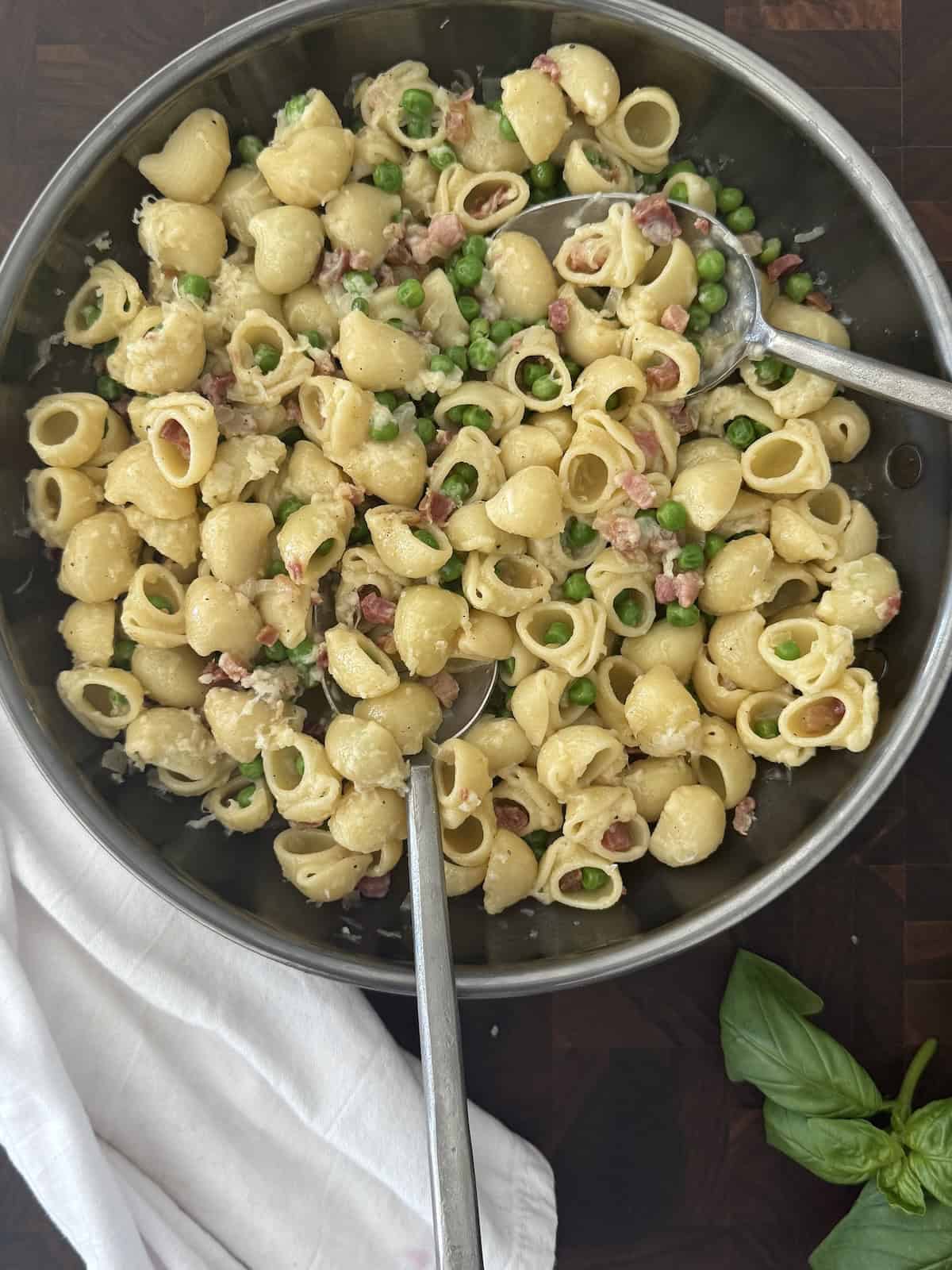mains
personal
appetizers
desserts
pasta
Categories:
Hey there!
I'm so happy you're here! I hope that you find your next favorite recipe here and get inspired, with love for Italian meals!
Last Updated on April 17, 2025 by Jenn Laprade
This Pasta e Piselli, also known as pasta with peas, is a classic Italian one-skillet pasta recipe made with pancetta, shallots, peas, and two types of cheese. It comes together in just 30 minutes with ingredients from your fridge and pantry.
Pasta Piselli was one of those dishes that my grandmother always had on the stove. Whether it was warm and ready for lunch or tucked into the fridge to reheat when company came over, pasta with peas was a staple in her kitchen. My mom made it for us growing up too, and now it’s something I turn to when I want a meal that feels nostalgic but still packs incredible flavor.
This version of Pasta e Piselli adds pancetta for a salty, savory twist—but it keeps all the simplicity of the original. Made in one skillet and using fewer than 10 ingredients, it’s the kind of meal you can make on a busy weeknight or dress up with a little fresh basil and Parmesan for guests.
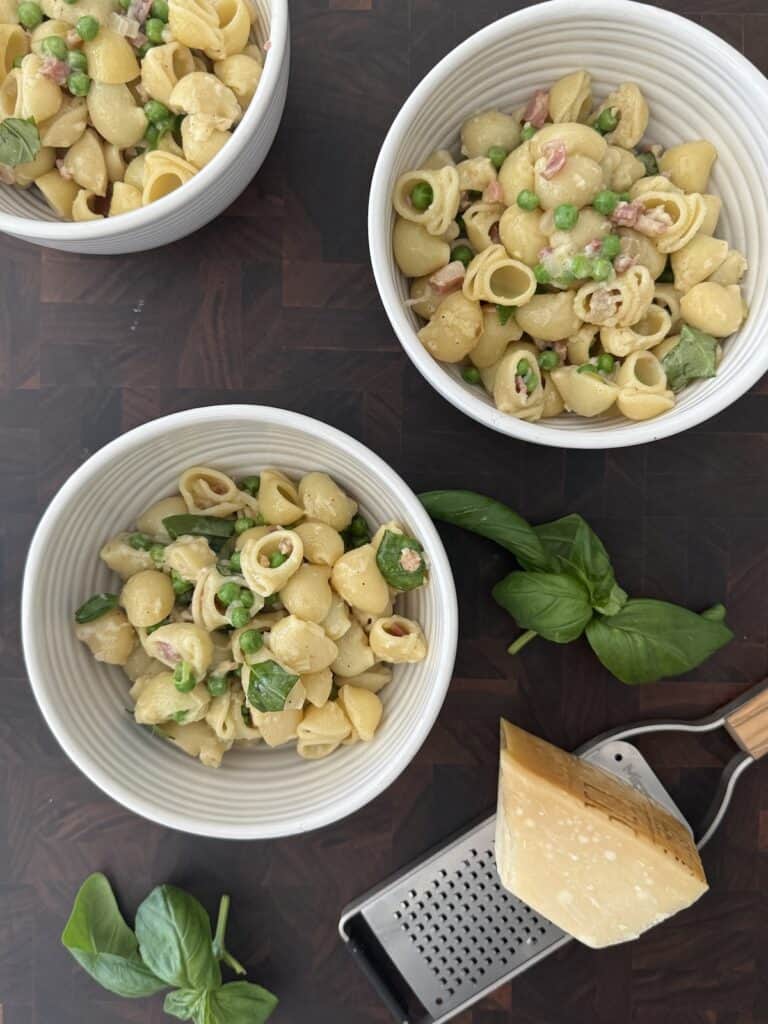
Table of Contents
Why You’ll Love This Recipe
- Ready in 30 minutes. This is your new go-to weeknight pasta—quick to make, easy to love, and satisfying every time.
- Cooked in one skillet. Less mess, fewer dishes, and all the flavor builds in one pan for max convenience.
- Simple ingredients, big flavor. Salty pancetta, sweet peas, and starchy pasta water come together in a rich, creamy sauce—without needing cream.
- Pantry-friendly. You likely have everything you need already: dried pasta, frozen peas, olive oil, and some cheese.
- Perfect year-round. Light enough for spring with fresh basil and peas, cozy enough for colder months when you want comfort in a bowl
What Is Pasta e Piselli (pasta with peas)?
Pasta e Piselli (pronounced PAHS-tah eh pee-ZELL-ee) translates to “pasta and peas” in Italian. Traditionally from Naples and southern Italy, it’s a humble dish typically made without meat—just peas, onion, and short pasta simmered together to create a creamy, starchy sauce.
This version adds crispy pancetta and finishes the dish with Parmesan and Pecorino Romano, giving it a deeper, more savory flavor while keeping that soft, comforting texture. The sauce should lightly coat the noodles—not soupy, not dry—with tender peas in every bite.
Jenn’s Tip:
Use the reserved starchy pasta water and freshly grated cheeses to create a naturally creamy sauce—no cream needed. The starch from the pasta water helps bind the butter and cheese into a silky, restaurant-worthy finish.
Ingredients
- Short pasta – Ditalini, small shells, or orecchiette all work well.
- Extra virgin olive oil – Builds the base of the sauce and crisps the pancetta.
- Pancetta, diced – Adds salty depth and a crisp texture.
- Shallot, finely chopped – A mellow aromatic base.
- Garlic cloves, minced – Adds gentle, aromatic flavor.
- Frozen peas – Sweet and creamy; fresh peas work too when in season.
- Salt (adjust to taste) – Start light; pancetta and cheese add more saltiness.
- Reserved pasta water – Helps emulsify the sauce and give it body.
- Unsalted butter – Adds richness and helps bind the sauce.
- Freshly grated Pecorino Romano – Sharp, salty, and bold.
- Freshly grated Parmigiano Reggiano – Nutty and smooth; balances the Pecorino.
- Basil (plus more for garnish) – Optional, but adds freshness.
- Black pepper, to taste – Freshly ground works best.
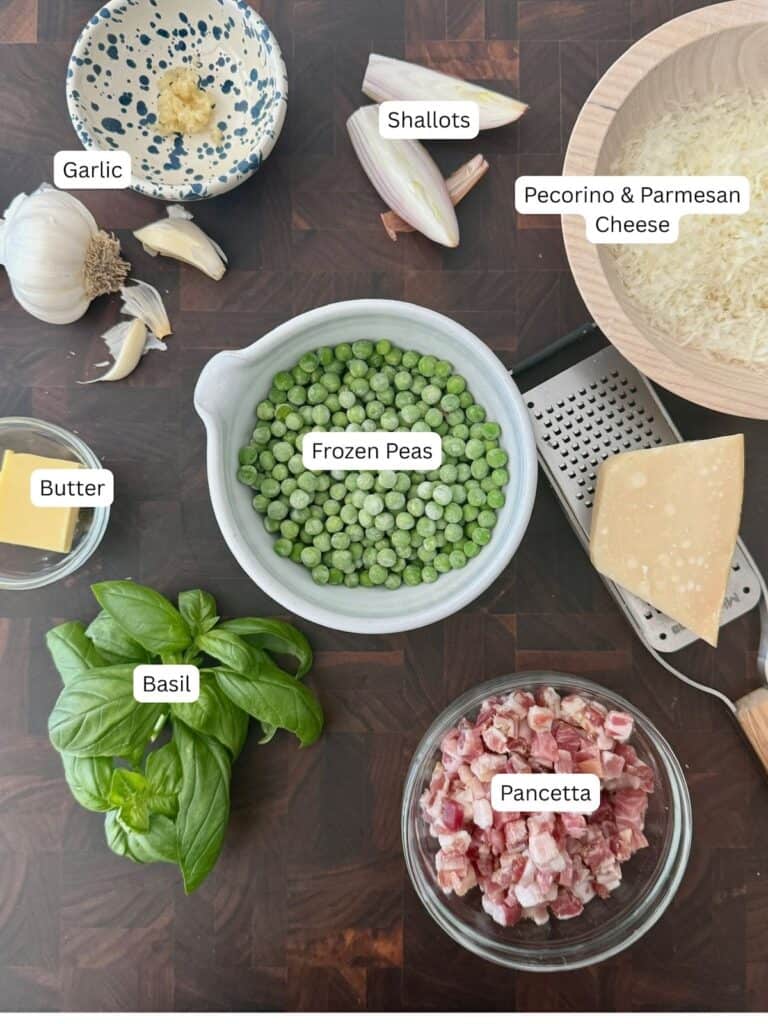
How to Make Pasta e Piselli
- Boil the pasta. Bring a large pot of salted water to a boil. Cook until just shy of al dente. Reserve ¼ cup pasta water, then drain.
- Crisp the pancetta. In a large skillet over medium heat, add olive oil and pancetta. Cook until browned and crispy, then transfer to a plate. Leave the rendered fat in the pan.
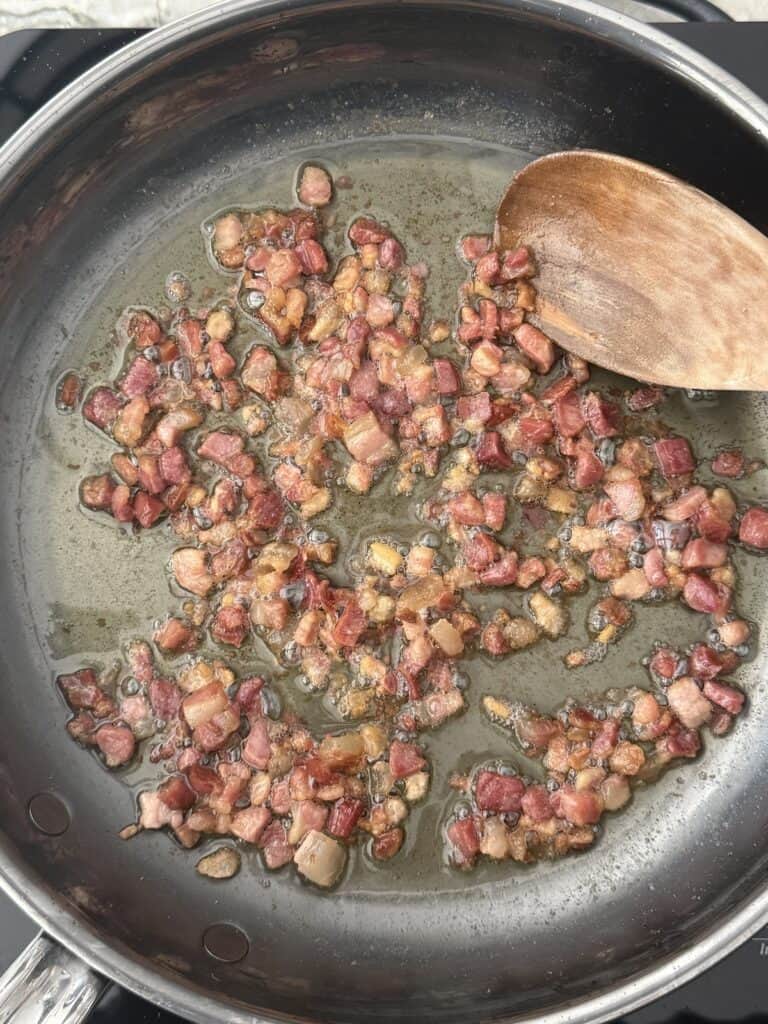
3. Sauté the aromatics. Reduce heat to medium-low. Add the shallot and garlic and cook for 2–3 minutes until soft and fragrant.
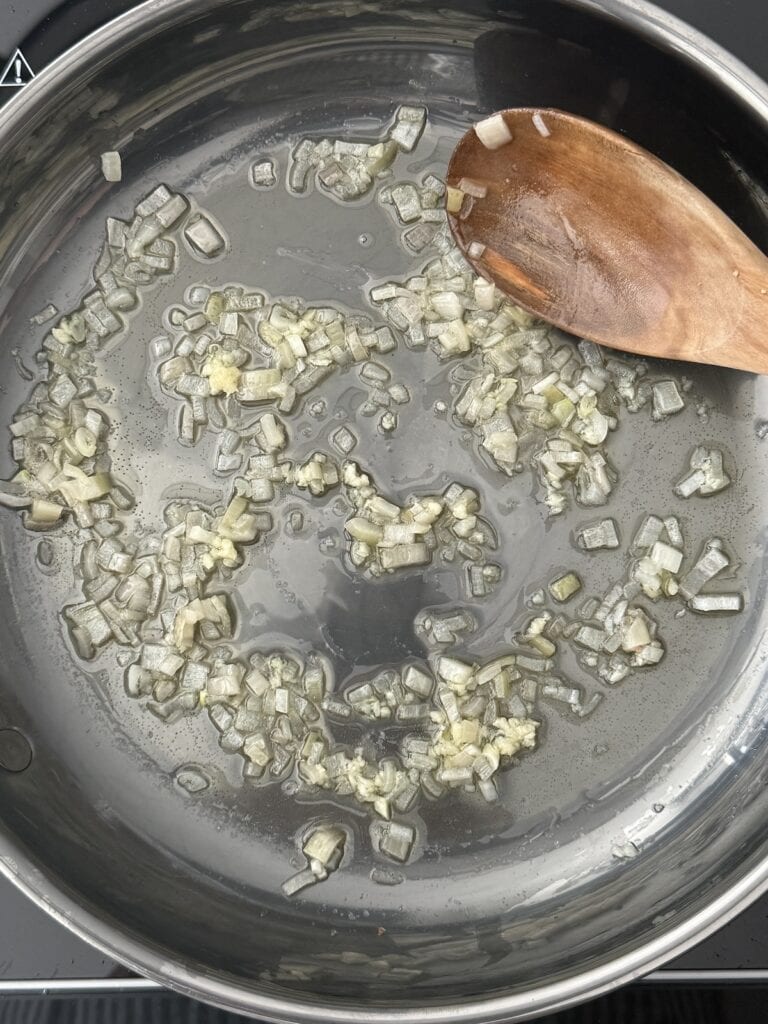
4. Add the peas. Stir in the frozen peas and salt. Cook for 2 minutes to soften and absorb flavor.
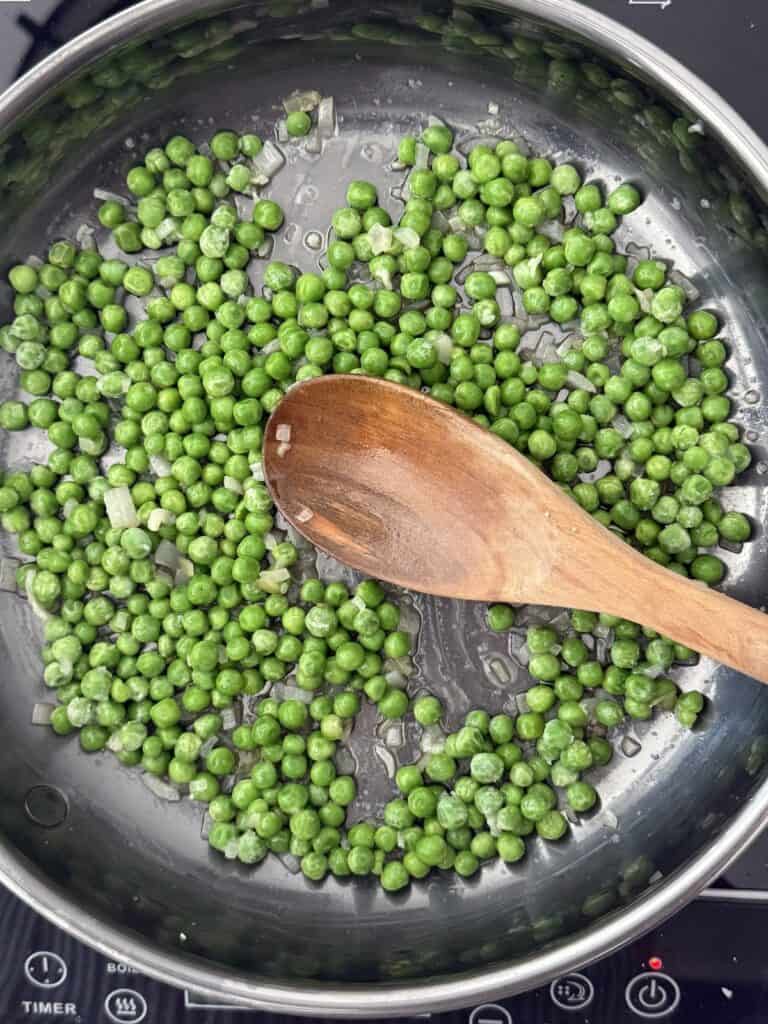
5. Create the sauce. Return pancetta to the pan. Add drained pasta and reserved pasta water. Stir gently, then add butter, cheese, and basil. Stir until the sauce is creamy and coats the pasta.
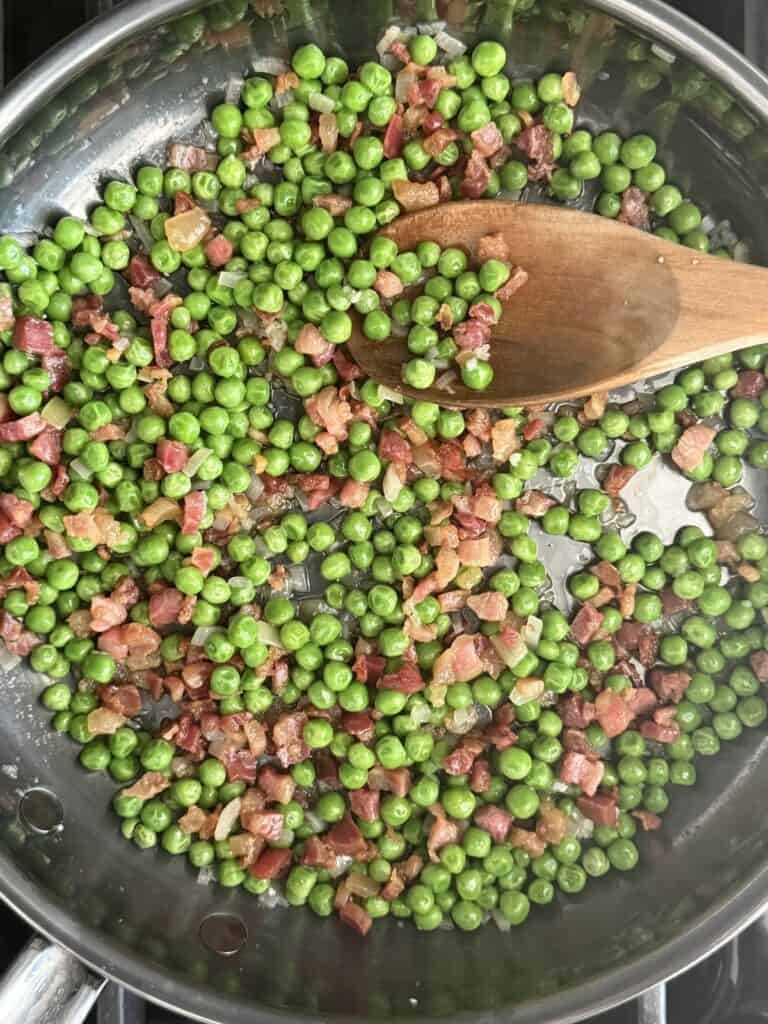
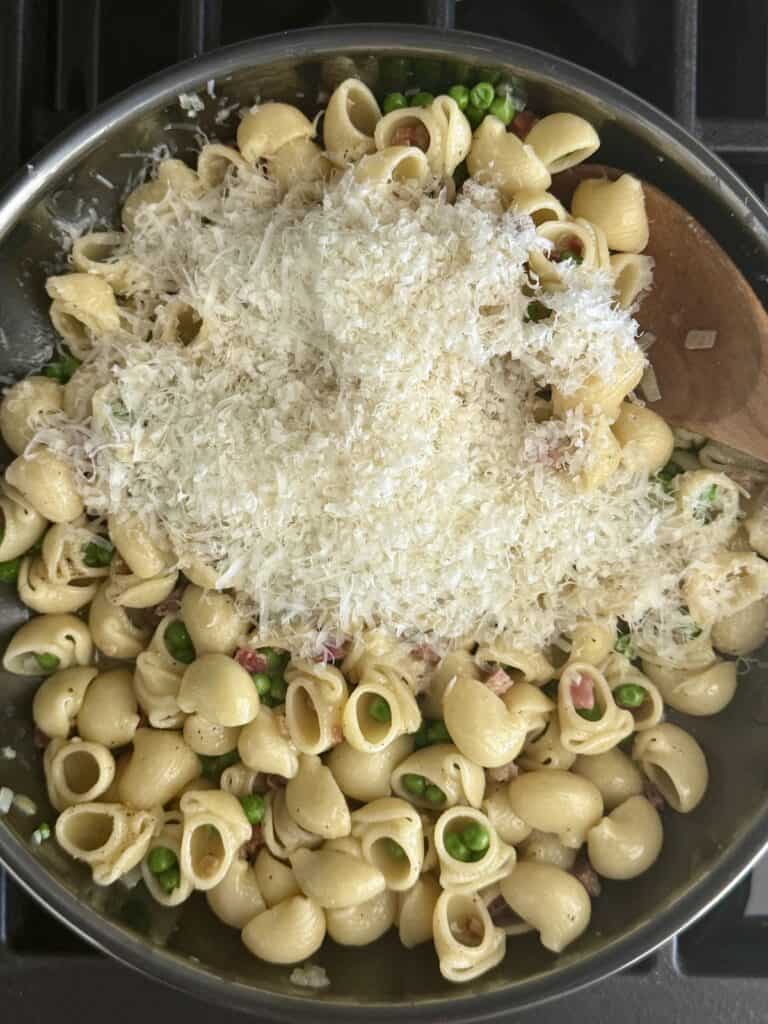
6. Season and serve. Taste and adjust with black pepper and more salt if needed. Add more pasta water to loosen the sauce if necessary. Garnish with more basil and cheese.
Substitutions and Variations
- Swap pancetta for bacon. If you don’t have pancetta, diced bacon works just fine. It adds a smoky, salty flavor and crisps up nicely in the pan.
- Make it meatless. Skip the pancetta and start with olive oil, shallots, and garlic—just like my grandmother did. It’s still cozy and full of flavor.
- Add baby spinach. Toss in a handful at the end and let it wilt into the sauce. It’s an easy way to add more greens without changing the flavor.
- Use fresh peas in spring. If you can find them, use fresh peas—they add a delicate sweetness and a pop of bright green that’s perfect for warmer months.
- Try a different pasta shape. Ditalini is traditional, but small shells, orecchiette, or even elbow macaroni will work well and hold the sauce nicely.
Expert Tips for the perfect Pasta Piselli
- Salt your pasta water well. It should taste like the sea—this is key to flavor!
- Don’t skip the reserved pasta water. It helps emulsify and thicken the sauce naturally.
- Mash a few peas. This trick adds creaminess without needing cream.
- Avoid overcooking the peas. Add them last so they stay tender, not mushy.
- Grate your own cheese. Pre-grated cheese won’t melt the same way and could make the sauce gritty.
- Use both Parmesan and Pecorino if you can. Pecorino adds a salty bite, while Parmesan brings a nuttier, milder flavor. Together, they give the sauce more depth—but just Parmesan still works beautifully.
Storage and Freezing
Pasta e Piselli is best enjoyed fresh, but leftovers keep well for up to 4 days in the fridge. Store in an airtight container, and reheat gently with a splash of water or broth to bring back the creaminess.
To freeze, let it cool completely and transfer to freezer-safe containers. It may lose a bit of its texture when thawed, but you can revive it with a little extra cheese and butter. It’s a great way to keep comfort food ready to go.
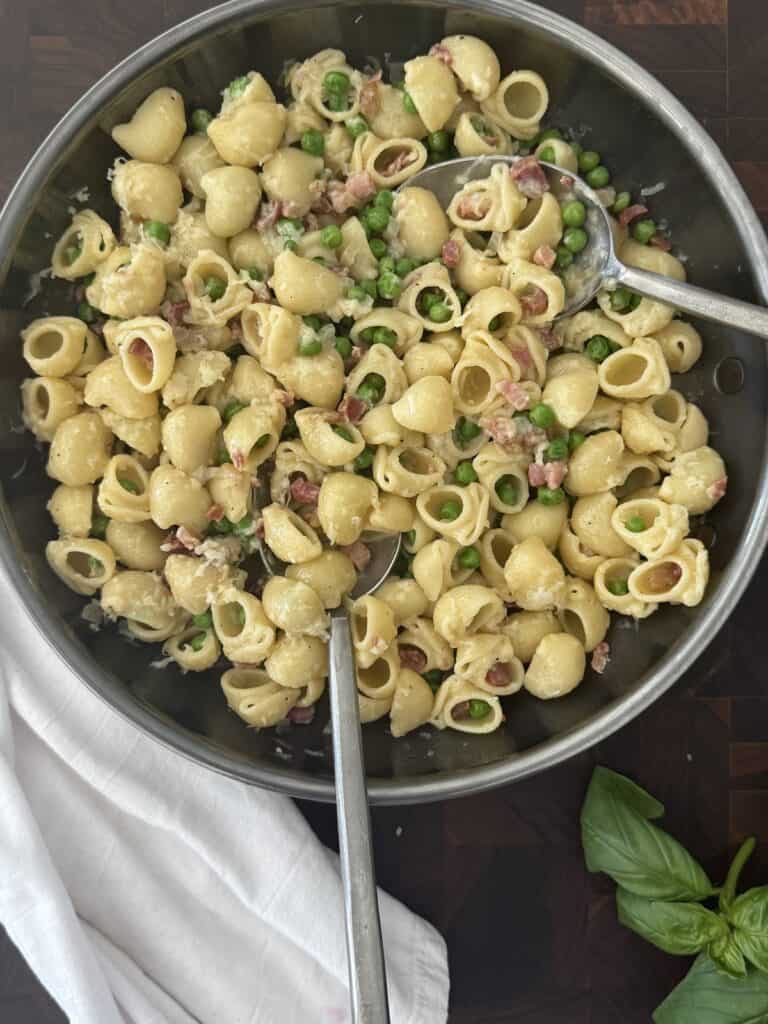
FAQs
Ditalini is the most traditional, but mezzi rigatoni, small shells, or orecchiette work just as well.
Yes, you can—but keep in mind that “piselli” means peas in Italian, so peas are the star of this dish. That said, feel free to experiment with seasonal vegetables like chopped zucchini, asparagus, or corn if you’re looking to switch it up.
It should be creamy and slightly loose—not too thick, not watery. Add a bit of pasta water to loosen it up if needed.
Mash some peas into the sauce, stir in extra cheese, or add a small pat of butter right before serving.
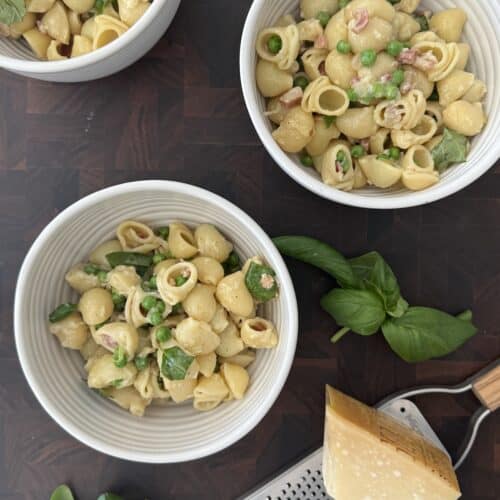
Pasta e Piselli (Pasta with Peas)
Equipment
- 1 Large Pot for boiling pasta
- 1 large skillet for sautéing and tossing pasta together
Ingredients
- 1 pound Short pasta datalini, small shells, or orecchiette
- 2 Shallots, finely chopped
- 2 Garlic cloves, minced
- 6 ounces Pancetta, diced
- 1 1/2 cups Frozen peas
- 2 tbsp Unsalted butter
- 3/4 cup Freshly grated Pecorino Romano
- 3/4 cup Freshly grated Parmigiano Reggiano
- Salt & pepper to taste
- 1/4 cup Fresh basil, chopped
- Extra virgin olive oil, for serving
Instructions
- Bring a large pot of salted water to a boil and cook pasta until al dente. Reserve 1/2 cup of pasta water, then drain and set aside.
- In a large skillet over medium heat, add the olive oil and the pancetta. Cook until crispy and golden brown, about 4–5 minutes. Using a slotted spoon, transfer the pancetta to a plate and set aside, leaving the rendered fat in the pan.
- Reduce the heat to medium-low. Add the shallot to the skillet and cook for 2 minutes, until softened. Stir in the garlic and cook for 30 seconds, until fragrant.
- Stir in the frozen peas and season with salt. Cook for 2 minutes, allowing them to absorb the flavors.
- Return the pancetta to the skillet, then add the drained pasta and the butter, stirring until melted, then gradually mix in the Pecorino Romano, Parmigiano Reggiano, and fresh basil (if using), stirring until the sauce turns silky and coats the pasta.
- If the sauce is too thick, add a splash of pasta water to loosen it. Garnish with extra fresh basil, a drizzle of extra virgin olive oil and serve immediately.
Notes
Expert Tips
-
- Salt your pasta water well. It should taste like the sea—this is key to flavor!
-
- Don’t skip the reserved pasta water. It helps emulsify and thicken the sauce naturally.
-
- Mash a few peas. This trick adds creaminess without needing cream.
-
- Avoid overcooking the peas. Add them last so they stay tender, not mushy.
-
- Grate your own cheese. Pre-grated cheese won’t melt the same way and could make the sauce gritty.
-
- Use both Parmesan and Pecorino if you can. Pecorino adds a salty bite, while Parmesan brings a nuttier, milder flavor. Together, they give the sauce more depth—but just Parmesan still works beautifully.
Storage and Freezing
- Pasta e Piselli is best enjoyed fresh, but leftovers keep well for up to 4 days in the fridge. Store in an airtight container, and reheat gently with a splash of water or broth to bring back the creaminess.
- To freeze, let it cool completely and transfer to freezer-safe containers. It may lose a bit of its texture when thawed, but you can revive it with a little extra cheese and butter. It’s a great way to keep comfort food ready to go.
Nutrition
©️ 2025 Italy In Your Kitchen | Easy Italian Recipes | Italian Food Blogger
